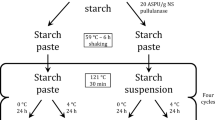Abstract
Potato tubers have been successfully used for high-level production of a recombinant single-chain Fv (ScFv) antibody. Ubiquitous high-level expression was achieved under control of the CaMV 35S promoter through retention of the scFv protein in the endoplasmic reticulum. Recombinant antibodies accumulated up to 2% of total soluble tuber protein. After 1.5 years of tuber storage at 4 °C still half of the amount of scFv present in freshly harvested tubers was detectable. Its specific activity did not decrease during tuber storage. Recombinant protein could be efficiently purified from crude extracts by affinity chromatography.
Similar content being viewed by others
References
Arntzen CJ: High-tech herbal medicine: plant-based vaccines.Nature Biotechnol 15: 221–222 (1997).
Artsaenko O, Peisker M, Zur Nieden U, Fiedler U, Weiler EW, Müntz K, Conrad U: Expression of a single-chain Fv antibody against abscisic acid creates a wilty phenotype in transgenic tobacco. Plant J 8: 745–850 (1995).
Bird RE, Hardman KD, Jacobsen JW, Johnson S, Kaufman BM, Lee SM, Lee T, Pope SH, Riordan GS, Whitlow M: Single-chain antigen binding proteins. Science 242: 423–426 (1988).
Düring K, Porsch P, Fladung M, Lörz H: Transgenic potato plants resistant to the phytopathogenic bacterium Erwinia carotovora. Plant J 3: 587–598 (1993).
Fiedler U: Hochexpression rekombinanter Anitkörperfragmente in transgenen Pflanzen. Ph.D. thesis, Martin-Luther-Universität Halle-Wittenberg, Germany. (1996).
Fiedler U, Conrad U: High-level production and long-term storage of engineered antibodies in transgenic tobacco seeds. Biotechnology 13: 1090–1093 (1995).
Fiedler U, Phillips J, Artsaenko O, Conrad U: Optimization of scFv antibody production in transgenic plants. Immunotechnology 3: 205–216 (1997).
Goddijn OJM, Pen J: Plants as bioreactors. Trends Biotechnol 13: 379–387 (1995).
Haq TA, Mason HS, Clements JD, Arntzen CJ: Oral immunization with a recombinant bacterial antigen produced in transgenic plants. Science 268: 714–716 (1995).
Hiatt A, Cafferkey R, Bowdish K: Production of antibodies in transgenic plants. Nature 342: 76–78 (1989).
Hoogenboom HR: Designing and optimizing library selection strategies for generating high-affinity antibodies. Trends Biotechnol 15: 62–70 (1997).
Kusnadi AR, Nikolov ZL, Howard JA: Production of recombinant proteins in transgenic plants: Practical considerations. Biotechnol Bioeng 56: 473–484 (1997).
Munro S, Pelham HRB: A C-terminal signal prevents secretion of luminal ER proteins. Cell 48: 899–907 (1987).
Odell JT, Nagy F, Chua NH: Identification of DNA sequences required for activity of the cauliflower mosaic virus 35S promoter. Nature 313: 810–812 (1985).
Owen M, Gandecha A, Cockburn B, Whitelam G: Synthesis of a functional anti-phytochrome single-chain Fv protein in transgenic tobacco. Biotechnology 10: 790–794 (1992).
Owen MRL, Cockburn W, Whitelam GC: The expression of recombinant antibody fragments in plants. In: Owen MRL, Pen J (eds) Transgenic Plants: A Production System for Industrial and Pharmaceutical Proteins, pp. 245–260. John Wiley, Chichester (1996).
Phillips J, Artsaenko O, Fiedler U, Horstmann C, Mock HP, Müntz K, Conrad U: Seed-specific immunomodulation of abscisic acid activity induces a developmental switch. EMBO J 16: 4489–4496 (1997).
Rocha-Sosa M, Sonnewald U, Frommer W, Stratmann M, Schell J, Willmitzer L: Both developmental and metabolic signals activate the promoter of a class I patatin gene. EMBO J 8: 23–29 (1989).
Sambrook J, Fritsch EF, Maniatis T: Molecular Cloning: A Laboratory Manual, 2nd ed. Cold Spring Harbor Laboratory, Cold Spring Harbor, NY (1989).
Shouten A, Roosien J, van Engelen FA, de Jong GAM, Borst-Vrenssen AWM, Zilverentant JF, Bosch D, Stiekema WJ, Gommers FJ, Schots A, Bakker J: The C-terminal KDEL sequence increases the expression level of a single-chain antibody designed to be targeted to both the cytosol and the secretory pathway in transgenic tobacco. Plant Mol Biol 30: 781–793 (1996).
Author information
Authors and Affiliations
Rights and permissions
About this article
Cite this article
Artsaenko, O., Kettig, B., Fiedler, U. et al. Potato tubers as a biofactory for recombinant antibodies. Molecular Breeding 4, 313–319 (1998). https://doi.org/10.1023/A:1009676832273
Issue Date:
DOI: https://doi.org/10.1023/A:1009676832273




